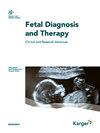使用分泌型 IgA 的经羊膜胎儿免疫疗法 (TRAFIT):预防坏死性小肠结肠炎的潜在新型辅助策略。
IF 1.6
3区 医学
Q3 OBSTETRICS & GYNECOLOGY
引用次数: 0
摘要
简介分泌性免疫球蛋白-A(SIgA)不会在围产期产生,它能与细菌结合,增强粘膜免疫能力。SIgA 结合的肠道细菌水平越高,对坏死性小肠结肠炎越有保护作用。经羊膜胎儿免疫疗法(TRAFIT)曾被用于向胎儿消化道输送 SIgA,但其功能影响尚不明确。我们试图确定通过 TRAFIT 给药的 SIgA 是否能在出生后与肠道细菌发生功能性结合。方法四个母体的胎儿(38 个)在妊娠第 19 天(E19;足月=E22-E23)接受了人类 SIgA 的羊膜腔内注射。自然分娩后,幼崽在产后存活 1-2 天,然后采集肠道内容物并进行流式细胞术检测。标本经细菌(Syto-GFP)和人SIgA(PE)染色,以防止与母体大鼠SIgA发生交叉反应。结果总存活率为94.7%(36/38)。在所有时间点的所有样本中都发现了 SIgA-细菌复合物,显示 PE 阳性事件明显高于未染色对照组(p=0.03-0.05)。结论用分泌型 IgA 进行经羊膜胎儿免疫治疗可使 IgA 结合细菌进入出生后阶段,这可能是增强早期粘膜免疫的一种新策略,有可能保护新生儿免受坏死性小肠结肠炎的侵害。本文章由计算机程序翻译,如有差异,请以英文原文为准。
Transamniotic Fetal Immunotherapy (TRAFIT) with Secretory IgA: A Potential Novel Ancillary Strategy for the Prevention of Necrotizing Enterocolitis.
INTRODUCTION
Secretory immunoglobulin-A (SIgA), which is not produced perinatally, binds bacteria enhancing mucosal immunity. Higher levels of intestinal bacteria bound by SIgA are protective against necrotizing enterocolitis. Transamniotic fetal immunotherapy (TRAFIT) has previously been used to deliver SIgA to the fetal digestive tract, however with unclear functional impact. We sought to determine whether SIgA administered via TRAFIT could functionally bind intestinal bacteria postnatally.
METHODS
Fetuses (n=38) from four dams underwent intra-amniotic injections of human SIgA on gestational-day 19 (E19; term=E22-E23). After spontaneous delivery, pups were survived for 1-2 days postnatally before intestinal contents were procured and submitted to flow cytometry. Specimens were stained for bacteria (Syto-GFP) and human-SIgA (PE) to prevent cross-reactivity with maternal rat SIgA.
RESULTS
Overall survival was 94.7% (36/38). SIgA-bacterial complexes were identified in all samples at all time points showing significantly higher positive PE events than unstained controls (p=0.03-0.05). The proportion of bacteria bound by IgA decreased daily, from 45.6% to 29.9% bound at 4 to 6 days post-TRAFIT, respectively (overall p=0.05).
CONCLUSIONS
Transamniotic fetal immunotherapy with secretory-IgA leads to functionally IgA-bound bacteria into the postnatal period and may be a novel strategy for enhancing early mucosal immunity, potentially protecting the neonate against necrotizing enterocolitis.
求助全文
通过发布文献求助,成功后即可免费获取论文全文。
去求助
来源期刊

Fetal Diagnosis and Therapy
医学-妇产科学
CiteScore
4.70
自引率
9.10%
发文量
48
审稿时长
6-12 weeks
期刊介绍:
The first journal to focus on the fetus as a patient, ''Fetal Diagnosis and Therapy'' provides a wide range of biomedical specialists with a single source of reports encompassing the common discipline of fetal medicine.
 求助内容:
求助内容: 应助结果提醒方式:
应助结果提醒方式:


